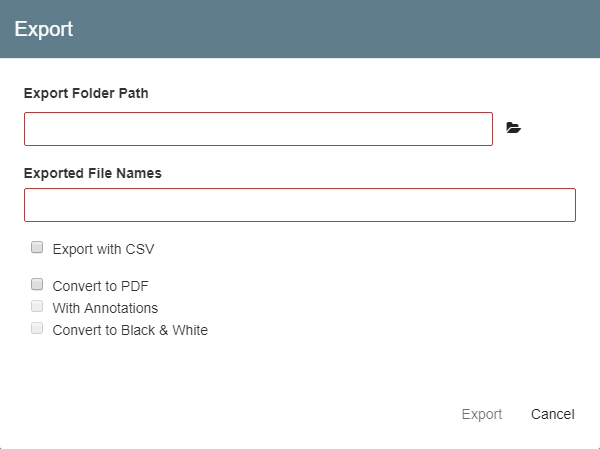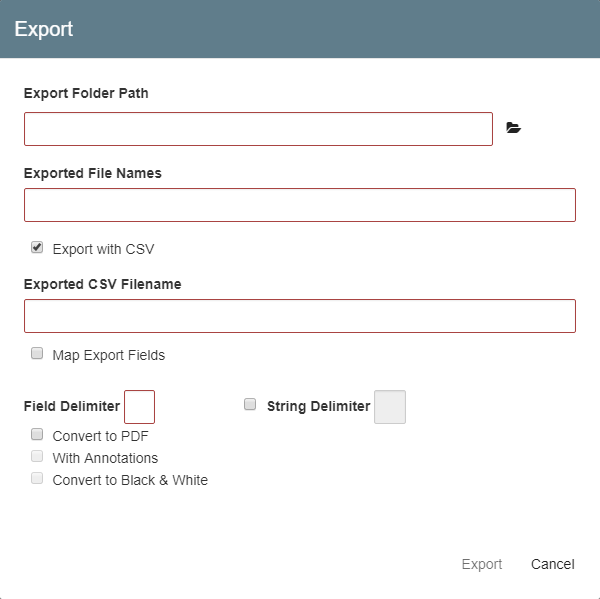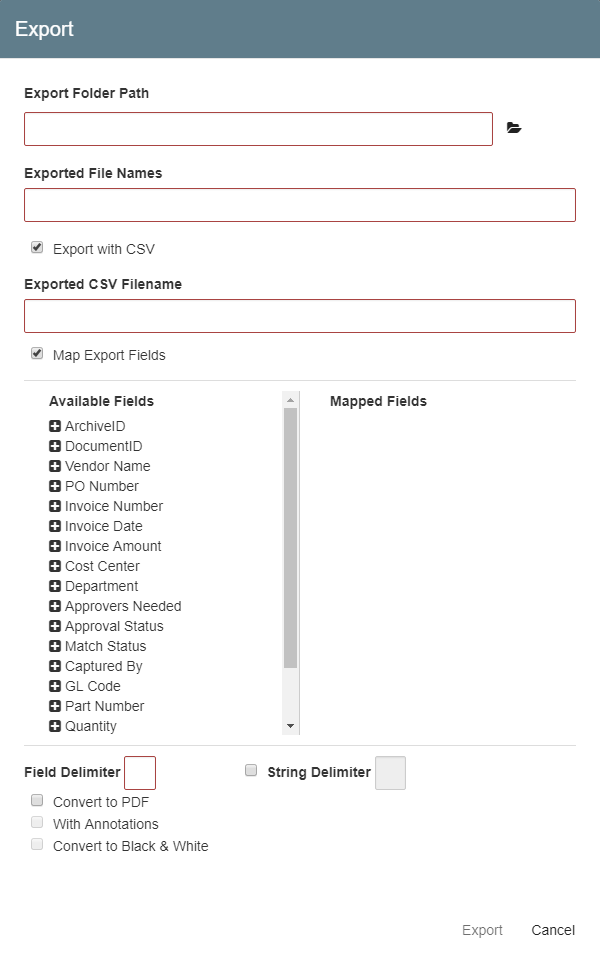You can export documents from GlobalSearch in their original file format or as PDF files, and choose to export them with or without indexing data or annotations. To export, enable the IO extension, and then choose Export in the Actions menu.
If you do not have the IO extension enabled, you can still export just your documents. A single document will export to your browser’s default download directory in the file’s original format, in a file called "Square9Export." If more than one document is selected, a compressed ZIP file called “Export.zip” is created. For GlobalSearch C2 customers, note that Export is only supported via the IO extension.
Document selections do not persist across results pages or Archives (in the case of multi-archive searches). If you intend on exporting a collection of documents that would span results pages, increase the results page count so all documents flagged for export show on a single page. Alternately, create a search that limits the desired documents to a single page. For multi-archive search results, documents must be separately exported from each archive.
Export requires View, Export Documents, and Export Data permissions.
Export Documents
- Run a Search and select one or more documents in the Search Results or open a document in the Document Viewer.
- In the Actions menu, select Export.
When using Export from the Document Viewer, the document (named Square9Export) will be downloaded to your computer in it's original format. Additional options are provided when exporting from a Search Result, described below. - In the Export dialog that appears when exporting from Search Results, enter or browse to the folder path the document will be exported to in the Export Folder Path text box. This is the destination folder where files will be saved. The export process will create a folder beneath the specified export folder, named with the Archive name of the selected documents. Keep this in mind when naming folders. It would be unnecessary to export documents in an Archive name Vendor Invoices to a destination folder named Vendor Invoices, as this would result in two folders with the same name. A better approach is to create a folder named Exports or Exports_<Today's Date>, and use that as the target folder.
- Using the Browse For Folder interface, you can create a new folder in your chosen location.
- Using the Browse For Folder interface, you can create a new folder in your chosen location.
- Specify names for your files in the Exported File Names text box. For example filenames might represent the document type or account number for the documents being exported. If no filename is provided, a randomly generated unique filename will be used. If you choose a naming convention that will create duplicate file names, the files will be made unique with a numeric suffix.
- You can use S9 Notation to specify Index Field values for your file names. Enter a brace ( { ) and then select from the list of available Fields.
- You can use S9 Notation to specify Index Field values for your file names. Enter a brace ( { ) and then select from the list of available Fields.
- To convert the original document file format to PDF, enable Convert to PDF. If enabled, you can choose from the following:
- To convert with annotations, enable Annotations. (Note that if you do not have proper permissions, any annotations on the documents will be burned into a PDF at export. This means the users without annotation permissions will always export PDF files.)
- To convert color PDF files to black and white (which tend to make file sizes smaller), enable Convert to Black & White. Know that annotations can make an otherwise black & white document color. Use of Convert to Black & White is often recommended.
- Click Export. A pop-up message appears on the bottom-right corner of your desktop.
- When the export is complete, you can click on the message to go to your export location.
Export Data with Documents
- To include indexing data in the document export, in the Export dialog, enable Export with Index Data. New fields appear to configure a CSV file for your data.
- Enter the CSV file and its location in the Exported CSV Filename text box. Fix list numbering.
- You can export the data from all available Fields or choose just the ones that you need. To map Index Fields to CSV files, enable Map Export Fields.
- Click the Add (plus sign) icon for one or more Fields from the Available Fields list to move them to the Mapped Fields list.
- If needed, use the Delete (minus sign) to move them back.
- To change the order of the mapped fields in the CSV file, drag them using the Move (double-headed arrow) icon.
Tip: While optional, it is a good idea to include the ArchiveID and DocumentID system Fields to help identifying the exported documents.
- Enter the character to use for the CSV field delimiter in the Field Delimiter text box.
- Optionally, to configure a string delimiter, enable String Delimiter and enter a character in the text box. The default is a double quote mark (").




